Learning Centers
What are learning centers?
Centers are learning activities located in areas within the classroom. Children work in small groups as well as independently at these centers. Some activities are done with the teacher and some activities are completed with peers. Centers are an integral part of the school and can provide so many learning opportunities throughout the day. Young children learn through centers social interaction with both peers and adults, regulation of their behavior, language development, time management, turn taking skills, sharing, age-appropriate academics, and trying new activities in a safe environment. The specific activities would change based on theme, time of year, season, and students’ needs/interests.
Centers are learning activities located in areas within the classroom. Children work in small groups as well as independently at these centers. Some activities are done with the teacher and some activities are completed with peers. Centers are an integral part of the school and can provide so many learning opportunities throughout the day. Young children learn through centers social interaction with both peers and adults, regulation of their behavior, language development, time management, turn taking skills, sharing, age-appropriate academics, and trying new activities in a safe environment. The specific activities would change based on theme, time of year, season, and students’ needs/interests.
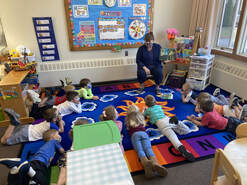
The Community Center (Circle Time) is an important part of the daily schedule. Circle time includes opportunities for stories, show-and-tell, and an exchange of the “news of the day.” The learning goals of the community center in our program include creating a sense of community. Each child, regardless of ability, language barriers, or shyness can experience a feeling of belonging to the group during circle time. Circle time also promotes the development of communication. Much of the effectiveness of circle time comes not only from language and developing communication skills but through the communication that occurs through the physical presence of other children, by holding each others hands, and the synchronization of movement. For example, it occurs through the use of a poem or song with hand motions supported by gesture as in the “itsy bitsy spider" song. It provides many opportunities for literacy through listening to stories, asking questions, and sharing information.
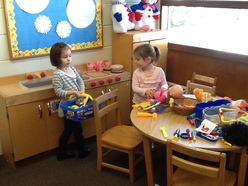
The dramatic play/home center provides children with opportunities for role playing, fun, and social interactions. A refrigerator, stove, sink, table and chairs set the backdrop for this center. This area changes to incorporate the theme, letter of the week, or season. Often this means changing the center into a flower shop, grocery store, space ship, doctor’s office, rainforest, post office, or even a bear cave! Throughout the year you will see dress up clothes, fabric, dolls, and countless props. Children learn about imagination and express it freely, assigned roles, conflicts resolved, and creativity at its best. Children learn empathy, tolerance, open-mindedness, and to develop autonomy.
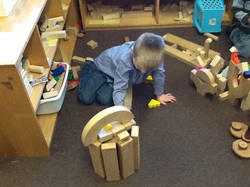
The block center offers many types of blocks, along with many other materials such as race tracks and cars, legos, trains, animals and so many other creative building supplies that offer perfect opportunities to develop fine motor skills and spatial awareness. Children learn to explore concepts such as balance, patterns, half/whole, shapes, cause and effect in this center. Children reinforce other concepts such as shapes, colors, and counting. The social aspect of building with friends creates many opportunities to solve problems, plan and re-plan, negotiate, share space and materials.
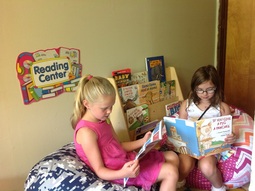
The Reading Center is a comfortable, quiet spot set up in the classroom, complete with soft colorful bean bags and a wide variety of books available for the children to read. The books can be related to the theme, season, or simply class interests. This is a quiet area where children can read independently, to each other, or listen while the teacher reads a story.

The Writing Center is a place where students can practice their writing skills and learn the stages of writing. The children can work independently using all the materials available to them within the writing center. The teacher works 1-1 or with a group of children. The activities in the writing center include making words with letter tiles, writing in journals, writing letters/mail, card making activities, letter of the week, and book-making.
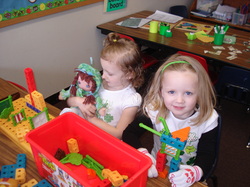
The Manipulatives and Math Center Children work on their fine motor skills in this center. This center includes activities like playing dice games, matching numeral cards to quantities of items, completing puzzles and sorting items. Children in this center learn about shapes, colors, numbers, and quantities. They also develop one-to-one correspondence as they sort and count materials, develop problem solving skills as they determine or learn rules to games and sharing materials, and turn rote counting skills into counting items or sets of items.
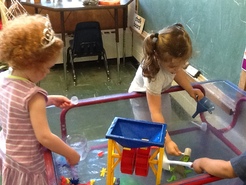
The multi-sensory room We create open-ended opportunities that allow for exploration of glue, paint, glitter, and many other materials. We present a wide variety of sensory experiences and many opportunities to be expressive and creative. While children are side by side creating, they learn to cooperate, negotiate, make their own choices, to wait, to question, and to observe. We also offer countless opportunities to practice their fine motor skills, including scissors and pencils. We also use the water table, sand table and offer different sensory opportunities such as play dough and shaving cream.
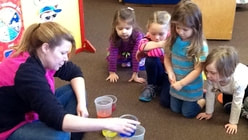
The science Center our goals include exploring and experiencing the natural world. We participate in problem solving and making guesses and estimates and developing observation skills. Our science area is 'hands-on' and interactive. We explore this center using all of our senses. Children's thinking skills and cognitive development is encouraged and promoted through questioning and exploring. We frequently utilize a chart or graph based on our latest experiment.
